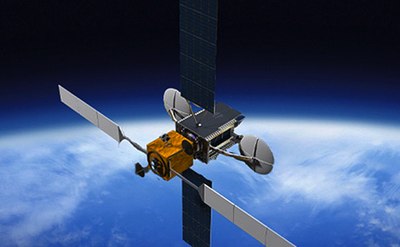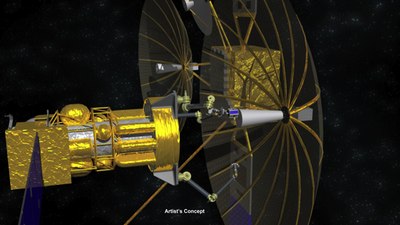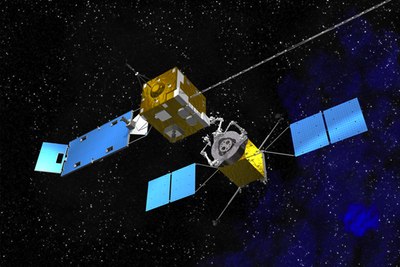The space industry grapples with satellite servicingby Jeff Foust
|
| With a very few exceptions, spacecraft cannot be serviced after launch, and in fact are not designed for such servicing. |
Less than 24 hours later, though, Intelsat reported there was an issue with its newly launched satellite. While one of its two solar arrays had deployed properly, there was a “delay”, as Intelsat put it, in the deployment of the satellite’s other array. If that array could not be deployed, the satellite’s power generating capacity would be cut in half, jeopardizing its ability to perform its mission.
About 10 days after launch, Intelsat announced that the stuck array on IS-19 had finally been released, a day after a series of thruster burns put the satellite into geosynchronous orbit. There are still concerns that the array may have been damaged, though, and the cause of the deployment problem is still unresolved.
However, if the thruster burns or other maneuvers had not freed the stuck panel, there was little else that engineers on the ground could have done to free it. With a very few exceptions—most notably the Hubble Space Telescope, with its multiple shuttle servicing missions—spacecraft cannot be serviced after launch, and in fact are not designed for such servicing. That is starting to change, though: several efforts, both government and commercial, are seeking to make satellite servicing viable. The challenges these efforts are finding are, in part, technological, as one might expect. The bigger challenges, though, may lie in the financial, legal, and other non-technical issues of fixing satellites.
 The ViviSat Mission Extension Vehicle would attach to an existing satellite that is running out of propellant and take over stationkeeping and attitude control. (credit: ViviSat) |
Developing the technology
Companies and organizations are exploring several different approaches to satellite servicing, with varying degrees of technical complexity. At one end are systems that want to take over the attitude control and propulsion capabilities of satellites, allowing those spacecraft running out of propellant but otherwise in good health to remain working. At the other end are efforts to do far more complex repairs to satellites, including even taking components from one satellite for use on another.
ViviSat, a joint venture of ATK and satellite operator US Space LLC, is operating at the simpler (or, perhaps more accurately, less complex) end of that technological spectrum. Its proposed Mission Extension Vehicle would attach to a satellite and take over the satellite’s stationkeeping activity. It would allow satellites whose own supplies of propellant are running out to stay in service, and also move satellites at the end of their lives out of GEO and into “graveyard” orbits at higher altitudes where they won’t pose a hazard to other operating satellites.
“The technology for this basic capability is in hand,” said Craig Weston, president and CEO of US Space, during a panel session about satellite servicing at the Women In Aerospace (WIA) annual conference in Arlington, Virginia, on June 1. “The most difficult thing at this point from our perspective is the rendezvous and the proximity ops,” that is, how to carefully approach and attach to a client satellite.
“We are now finalizing our design and are ready to build,” ViviSat COO Bryan McGuirk said during a satellite servicing session of the Satellite 2012 conference in Washington in March. “We’ve very excited about the milestones we’ve hit and the acceptance from the industry so far.”
| “Direct refueling, robotically, of a satellite is not trivial, but it’s fully doable,” said Dan King of MDA. |
Canadian aerospace company MacDonald, Dettwiler and Associates Ltd. (MDA) has proposed a more technically ambitious satellite servicing concept, leveraging its expertise developing the robotic arms for the Space Shuttle and the International Space Station. Its Space Infrastructure Servicing (SIS) vehicle, unveiled by the company last year, would dock with spacecraft. Instead of simply taking control of it, as with the case of ViviSat’s system, the SIS would use its manipulators to refuel or repair the spacecraft. The original announcement of the SIS by MDA in March of 2011 envisioned using it to deploy stuck arrays—like the case of IS-19—or grapple debris.
“Direct refueling, robotically, of a satellite is not trivial, but it’s fully doable,” said Dan King, vice president of business development at MDA Space Infrastructure Services, during the Satellite 2012 session. The fact that the SIS only needs to stay attached to the client satellite long enough to perform the refueling helps mitigate risks in the eyes of a customer, he added.
Similar to MDA’s concept is a technology development effort underway by NASA’s Satellite Servicing Capabilities Office (SSCO), based at Goddard Space Flight Center. That group, taking advantage of the in-space servicing expertise built up to support Hubble (including a proposed robotic servicing mission in lieu of the final shuttle servicing mission), is developing technologies to support the refueling and other servicing of satellites.
The current focus of the SSCO has been on an experiment called the Robotic Refueling Mission (RRM), mounted on the ISS on the final shuttle mission last summer (see “The mission of the final shuttle mission”, The Space Review, July 5, 2011). The RRM is designed to simulate the ways to access propellant tanks on satellites. Using the Dextre robotic manipulator on the ISS, engineers will test various methods to open valves, remove caps, and snip wires in order to gain access to a propellant tank and refuel it. Engineers just last week completed a second round of tests with the RRM, demonstrating techniques to remove caps leading to fuel lines. More tests are planned later this summer.
“We’ve very confident today that the technology does exist to do robotic servicing,” said Jill McGuire, the RRM project manager, at the WIA conference. “The robotic technology is what’s making it possible to do servicing at GEO and beyond.”
The SSCO plans to follow up the RRM with a full-fledged Robotic Servicing Mission (RSM), which would test out the refueling and other servicing technologies on a satellite in GEO. McGuire said their initial candidate satellite is GOES 12, a weather satellite launched in 2001 that has suffered some thruster leaks that has relegated the spacecraft to a backup role. “They have a decision point in the next few years coming up when they will run out of fuel,” she said. “The discussions we’ve been having with them is whether or not we can get there in time to refuel them. If for some reason we can’t refuel them, we could at least reposition them” and place them into a graveyard orbit.
| “We believe there is a ready market” for satellite servicing, said Weston, citing the 10 or so GEO satellites retired each year solely because they ran out of propellant. |
DARPA, meanwhile, is planning something even more ambitious. Its Project Phoenix, announced late last year, seeks to, as the agency puts it, “cooperatively harvest and re-use valuable components” from satellites in orbit that have been retired. DARPA envisions a servicing spacecraft that could remove a solar array, antenna, or other component from a defunct satellite and transport it to another satellite, either a newly-constructed spacecraft or one in need or repairs.
“Phoenix is truly all about going up to retired, non-cooperative, non-controlled satellites that have been left for dead in the graveyard orbit, essentially, and see if we can resurrect capability out of those satellites or those satellite components,” said Phoenix program manager Dave Barnhart at the WIA conference.
DARPA issued a Broad Agency Announcement (BAA) for the Phoenix program early this year, with another BAA for additional technologies planned for the near future. He said an in-space demonstration of the Phoenix concept is planned for around 2016.
 DARPA’s Phoenix program seeks to “harvest” components from retired satellites for use on existing or new ones. (credit: DARPA) |
Making the business and legal cases
Developers of satellite servicing technologies see a clear initial use for these systems: the hundreds of commercial communications satellites in GEO. These satellites are huge investments to companies—up to a few hundred million dollars each, depending on its size and complexity—but will generate several times that in revenue over its lifetime. Fixing an ailing satellite, or extending the life of one that is running out of propellant but is otherwise working fine, could be attractive to those satellites’ owners.
“We believe there is a ready market” for satellite servicing, said Weston. He noted that about 25 satellites in GEO are retired each year, of which 10 go out of service only because they have run out of propellant. “It is that set of satellites—that were it not for a lack of propellant could continue to do their mission—that we are currently targeting with a basic satellite servicing capability.”
Richard DalBello, vice president of Intelsat General, gave an example of a satellite that was rescued: Intelsat 603, which had been stranded in low Earth orbit until astronauts on the STS-49 shuttle mission in 1992 retrieved it and attached a new upper stage to allow it to go to GEO, where it still operates today. “I think we’re thinking of retiring that satellite next January,” he said at the WIA conference. “That satellite has made, since its rescue, over $800 million for our company.”
The revenue potential of such satellites means, he suggested, that operators may be willing to pay to repair satellites that fail to deploy their antennas or solar arrays. One example he cited was Intelsat’s New Dawn satellite, whose C-band antenna failed to deploy after its launch last year, costing Intelsat hundreds of millions of dollars in lost revenue. “If something goes wrong at the beginning, what would you pay?”
| “We want capable robots that have great eyes and have hands that can grab things,” said DalBello. “Those things scare people.” |
Yet, despite that reaction, those potential customers have been slow to emerge. ViviSat has not announced any customers for its Mission Extension Vehicle to date, although Weston said they are in discussions with a number of satellite operators. When MDA unveiled its SIS last year, it also said it had entered into an agreement with Intelsat to be the initial customer. However, in early January, MDA said the agreement with Intelsat “ceased to be in effect.”
“We’re a believer long-term in that concept” of satellite refueling, Intelsat CEO David McGlade said during a Satellite 2012 conference panel session in March. He said that their original agreement with MDA was to discuss the potential of MDA’s satellite servicing system, but that those discussions “didn’t pan out” at that time. “We still believe that there are opportunities there, and we’re pursuing them as we speak.”
“We see a lot of growing interest in this area,” said MDA’s King. He said that they were taking the time to take into account technology developments from government programs before proceeding with a commercial approach. “We have to sort out all the other opportunities out there.”
The difficulty these ventures have had in signing up customers has fueled a general skepticism among some in the industry about the business case for satellite servicing. “In almost 30 years I’ve seen a lot of satellite servicing proposals come across my desk,” said Chris Kunstadter, senior vice president of XL Insurance, at a Washington Space Business Roundtable luncheon on June 14. None of those ventures has been a success, although he said he eventually expects satellite servicing to emerge. “It’s an idea that’s just a little bit ahead of the technology.”
The key question is whether satellite servicing is financially viable: can a company providing, say, basic refueling services sell them at a price that is attractive to the satellite owner and still profitable for itself? At the National Space Society’s International Space Development Conference in Washington, DC, last month, Phil Kalmanson of NASA’s SSCO presented on some financial models developed by his office that suggest that satellite servicing could be financially viable.
“If I varied how much money I charged them,” he said, referring to a satellite servicer charging an operator for refueling, “is it still worth their time and money? And, yes, it is.” That was true, he said, when varying the propellant price from $500,000 to $1.5 million per kilogram, and also when assuming that some fraction of the communication satellite’s customers would be lost during the temporary disruption caused by the refueling.
Developing the business case and lining up customers are not the only issues satellite servicing faces. At the WIA conference, speakers expressed regulatory concerns: what sort of government oversight of satellite servicing is necessary, and under which agency’s jurisdiction? That concern goes hand-in-hand with another worry about satellite servicing: that a system designed to refuel or repair an ailing satellite could also be used to damage or otherwise disrupt an adversary’s satellite. Some speculate that DARPA’s interest in Phoenix is driven by the potential military applications of such a system.
“When you do something new, truly new, there’s no structure,” DalBello said. “Who says yes? Everyone can say no, but who can say yes? There is no ‘yes’ organization but there are hundreds of ‘no’ organizations.” He added that the technical capabilities of a satellite servicing system will cause concerns as well. “We want capable robots that have great eyes and have hands that can grab things. Those things scare people.”
| “It’s time to stop talking and start doing,” McGuire said. “We’ve been talking about this for years, and I think the technology’s here.” |
Barnhart said they were aware of those concerns at DARPA and planned to be as open as possible with any satellite servicing activities they perform. “For every single thing that we are doing, we are mandating transparency and positive control,” he said. He added that they would not touch any satellite in the graveyard orbit without a written agreement from the satellite’s owner.
To address some of these issues, DARPA is hosting a one-day workshop this Tuesday in Arlington, Virginia. Topics slated for discussion include the policy and legal issues associated with satellite servicing as well as its implications for international space stability and security.
Despite those issues, those in the satellite servicing field remain optimistic that their concepts will gain acceptance by—and thus contracts from—both commercial and government customers. Is there a tipping point for satellite servicing? “From a commercial perspective, I think the milestone is when a satellite operator, government or commercial, signs and announces a contract to do on orbit servicing,” Weston said. “I think that will, maybe not open the floodgates, but I think there will be a lot more other users that will be willing to sign on.”
DalBello had a slightly different take. “I think it will be like SpaceX. It’s not when they sign but when they do the first one,” he said. Once that servicing mission has been successfully completed, “a light bulb is going to go off on a bunch of people’s heads.”
“It’s time to stop talking and start doing,” McGuire said. “We’ve been talking about this for years, and I think the technology’s here. We’ve just got to jump in with both feet and do this.”
